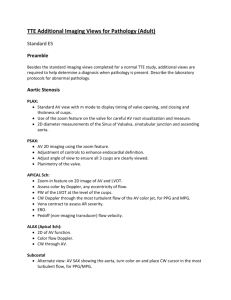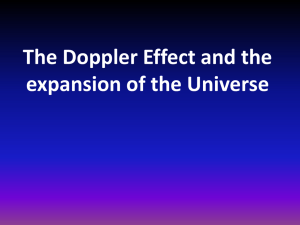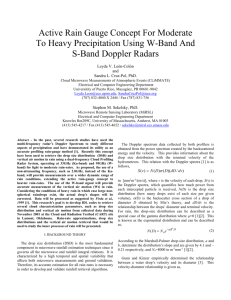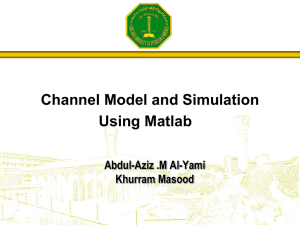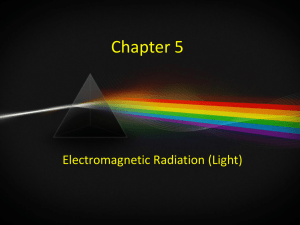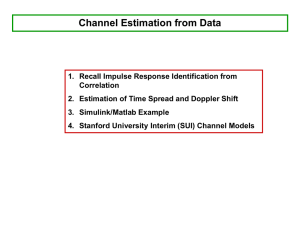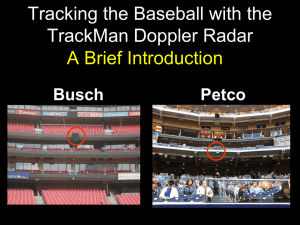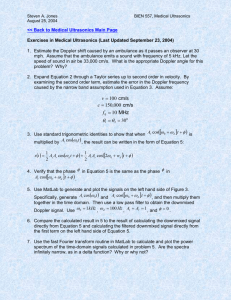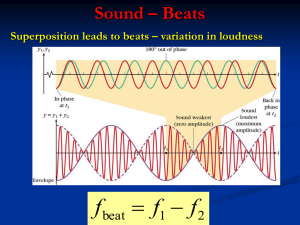View ePoster - 2015 AGU Fall Meeting
advertisement
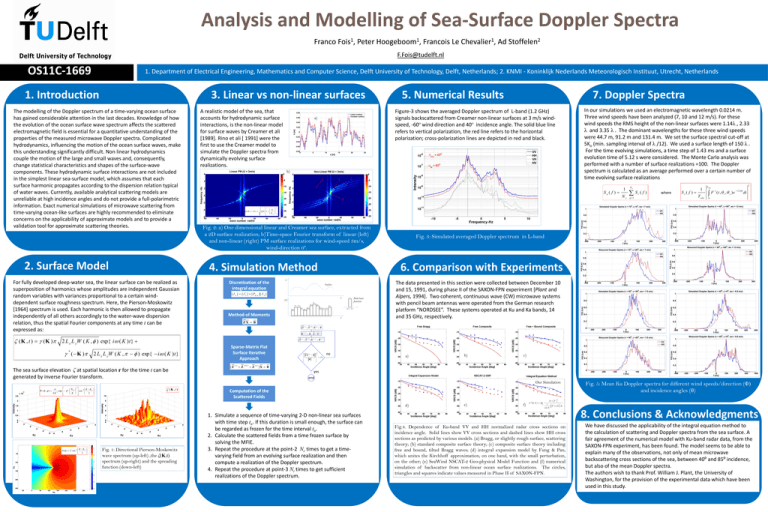
Analysis and Modelling of Sea-Surface Doppler Spectra
Franco Fois1, Peter Hoogeboom1, Francois Le Chevalier1, Ad Stoffelen2
F.Fois@tudelft.nl
OS11C-1669
1. Department of Electrical Engineering, Mathematics and Computer Science, Delft University of Technology, Delft, Netherlands; 2. KNMI - Koninklijk Nederlands Meteorologisch Instituut, Utrecht, Netherlands
1. Introduction
3. Linear vs non-linear surfaces
The modelling of the Doppler spectrum of a time-varying ocean surface
has gained considerable attention in the last decades. Knowledge of how
the evolution of the ocean surface wave spectrum affects the scattered
electromagnetic field is essential for a quantitative understanding of the
properties of the measured microwave Doppler spectra. Complicated
hydrodynamics, influencing the motion of the ocean surface waves, make
this understanding significantly difficult. Non linear hydrodynamics
couple the motion of the large and small waves and, consequently,
change statistical characteristics and shapes of the surface-wave
components. These hydrodynamic surface interactions are not included
in the simplest linear sea-surface model, which assumes that each
surface harmonic propagates according to the dispersion relation typical
of water waves. Currently, available analytical scattering models are
unreliable at high incidence angles and do not provide a full-polarimetric
information. Exact numerical simulations of microwave scattering from
time-varying ocean-like surfaces are highly recommended to eliminate
concerns on the applicability of approximate models and to provide a
validation tool for approximate scattering theories.
2. Surface Model
A realistic model of the sea, that
accounts for hydrodynamic surface
interactions, is the non-linear model
for surface waves by Creamer et ali
[1989]. Rino et ali [ 1991] were the
first to use the Creamer model to
simulate the Doppler spectra from
dynamically evolving surface
realizations.
a)
2 L x L yW ( K , ) exp{ i ( K ) t }
( K )
*
Sa ( f )
(K ) K
g K 1
The sea surface elevation ζ at spatial location r for the time t can be
generated by inverse Fourier transform.
Fig. 2: a) One dimensional linear and Creamer sea surface, extracted from
a 2D surface realization; b)Time-space Fourier transform of linear (left)
and non-linear (right) PM surface realizations for wind-speed 3m/s,
wind-direction 0º.
W (K , )
K0
4 w
exp
cos
3
4K
K
2
(K , t )
Fig. 1: Directional Pierson-Moskowitz
wave spectrum (up-left) ,the ζ(K,t)
spectrum (up-right) and the spreading
function (down-left)
q 1
where
Sr ( f )
T obs
F (t , i , s ) e
s
i 2 ft
dt
0
6. Comparison with Experiments
The data presented in this section were collected between December 10
and 15, 1991, during phase II of the SAXON-FPN experiment [Plant and
Alpers, 1994]. Two coherent, continuous wave (CW) microwave systems
with pencil beam antennas were operated from the German research
platform “NORDSEE”. These systems operated at Ku and Ka bands, 14
and 35 GHz, respectively.
Discretization of the
integral equation
[ J n ] [ J n ] [ Pm , n ][ J n ]
i
Method of Moments
ZX B
[Z
Sparse-Matrix Flat
Surface Iterative
Approach
[Z
(s)
Z
( FS )
Z
(w)
(s)
(s)
Z
( FS )
]X
( n 1 )
B Z
Z
( FS )
]X
(1 )
(w)
( n 1 )
B
X
(n)
B
( n 1 )
1
Z X (n) B 2
1%
B
no
a)
b)
c)
]X B
yes
end
Computation of the
Scattered Fields
d)
4 w
D ( ) C cos
2
Nr
Sr ( f )
1
2
T obs
Fig. 3: Simulated averaged Doppler spectrum in L-band
Our Simulation
2
1
Nr
2
K
K
m
[Z
2 L x L yW ( K , ) exp{ i ( K ) t }
In our simulations we used an electromagnetic wavelength 0.0214 m.
Three wind speeds have been analyzed (7, 10 and 12 m/s). For these
wind speeds the RMS height of the non-linear surfaces were 1.14λ , 2.33
λ and 3.35 λ . The dominant wavelengths for these three wind speeds
were 44.7 m, 91.2 m and 131.4 m. We set the surface spectral cut-off at
5Ko (min. sampling interval of λ /12). We used a surface length of 150 λ .
For the time evolving simulations, a time step of 1.43 ms and a surface
evolution time of 5.12 s were considered. The Monte Carlo analysis was
performed with a number of surface realizations =100. The Doppler
spectrum is calculated as an average performed over a certain number of
time evolving surface realizations
b)
B
( Κ , t ) ( K )
7. Doppler Spectra
Figure-3 shows the averaged Doppler spectrum of L-band (1.2 GHz)
signals backscattered from Creamer non-linear surfaces at 3 m/s windspeed, -60º wind direction and 40º incidence angle. The solid blue line
refers to vertical polarization, the red line refers to the horizontal
polarization; cross-polarization lines are depicted in red and black.
4. Simulation
Numerical Method for Scattering
4.
For fully developed deep-water sea, the linear surface can be realized as
superposition of harmonics whose amplitudes are independent Gaussian
random variables with variances proportional to a certain winddependent surface roughness spectrum. Here, the Pierson-Moskowitz
[1964] spectrum is used. Each harmonic is then allowed to propagate
independently of all others accordingly to the water-wave dispersion
relation, thus the spatial Fourier components at any time t can be
expressed as:
5. Numerical Results
1. Simulate a sequence of time-varying 2-D non-linear sea surfaces
with time step tn. If this duration is small enough, the surface can
be regarded as frozen for the time interval tn.
2. Calculate the scattered fields from a time frozen surface by
solving the MFIE.
3. Repeat the procedure at the point-2 Nt times to get a timevarying field from an evolving surface realization and then
compute a realization of the Doppler spectrum.
4. Repeat the procedure at point-3 Nr times to get sufficient
realizations of the Doppler spectrum.
e)
f)
( i , s ) lim
2 r F
0
r
1
cos i
F
i
s
Fig. 5: Mean Ku Doppler spectra for different wind speeds/direction (Φ)
and incidence angles (θ)
2
2
( x , 0 ) dx
Fig.4. Dependence of Ku-band VV and HH normalized radar cross sections on
incidence angle. Solid lines show VV cross sections and dashed lines show HH cross
sections as predicted by various models. (a) Bragg, or slightly rough surface, scattering
theory; (b) standard composite surface theory; (c) composite surface theory including
free and bound, tilted Bragg waves; (d) integral expansion model by Fung & Pan,
which unites the Kirchhoff approximation, on one hand, with the small perturbation,
on the other; (e) SeaWind NSCAT-2 Geo-physical Model Function and (f) numerical
simulation of backscatter from non-linear ocean surface realizations. The circles,
triangles and squares indicate values measured in Phase II of SAXON-FPN.
8. Conclusions & Acknowledgments
We have discussed the applicability of the integral equation method to
the calculation of scattering and Doppler spectra from the sea surface. A
fair agreement of the numerical model with Ku-band radar data, from the
SAXON-FPN experiment, has been found. The model seems to be able to
explain many of the observations, not only of mean microwave
backscattering cross sections of the sea, between 40º and 85º incidence,
but also of the mean Doppler spectra.
The authors wish to thank Prof. William J. Plant, the University of
Washington, for the provision of the experimental data which have been
used in this study.
